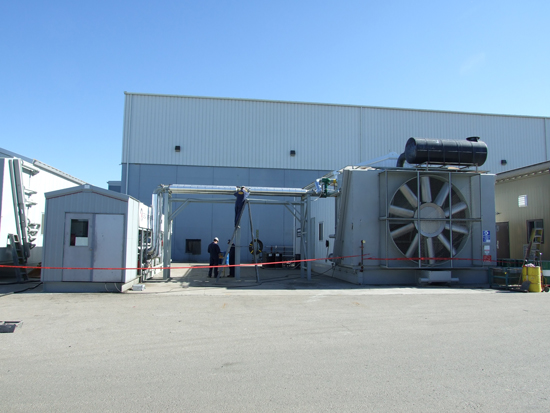Clean Power by Waste Heat Recovery from Reciprocating Engines
Lead proponent: Great Northern Power Corporation
Location: Compressor Stations in Alberta
CEF contribution: $ 978 K
Project total: $ 3,195 K
Project Background:

Test installation at fabricator’s shop
Reciprocating engines produce electricity using a combustible fuel and generator. Natural gas-fired reciprocating engines are typically used in the natural gas industry at pipeline compressor and storage stations and at gas processing plants. These engines provide mechanical shaft power for compressors and pumps by combusting fuel. However, only one third of the energy consumed is converted into mechanical shaft power and the other two thirds of the energy is typically lost as waste heat.
Great Northern Power (GNP) developed a system that converts waste heat into electricity. The “plug and play” system, called the “EXPANDER”, is designed to recover waste heat from reciprocating engines, such as the ones used in natural gas gathering systems, or in off-grid environments (remote communities and mines) and generate electricity. The system captures waste heat to produce energy in the form of shaft horsepower, and is expected to increase overall system efficiency of reciprocating engines by 10-15%.
GNP proposed a demonstration project to showcase their EXPANDER technology and prove that it is capable of recovering waste heat from 1,000 horsepower or larger engines, for power generation. The project, titled “Clean Power by Waste Heat Recovery from Reciprocating Engines”, was awarded $0.8M from the Clean Energy Fund.
Results:
GNP's EXPANDER is a skid-mounted waste-heat-to-electricity system that uses the Organic Rankine Cycle (ORC) process. For the project, an EXPANDER-175 was designed to capture waste heat from a stationary Caterpillar reciprocating engine - the engine typically used for natural gas transmission in North America. EXPANDER-175 was fabricated at a facility in Calgary. The company is a supplier of natural gas compression, oil and gas processing, refrigeration systems and power generation equipment. Once assembled, the system was connected to the fabricator’s full scale natural gas compressor, which supplied waste heat for testing. EXPANDER-175 proved to be capable of producing electricity from waste heat supplied by the compressor.
EXPANDER-175 was then shipped to the demonstration host site - a compressor station in Southern Alberta. There, it was connected to a turbo charged Cat 3516 compressor engine rated for 1156 HP. The compressor downtime required to install the EXPANDER unit was less than 18 hours. When installed, the system was tested and connected to the grid. Although the system successfully performed a dozen fully-automated run cycles and was able to generate power, reliable and continuous operation was affected by problems with the shaft seals in the expander component. As a result, the expander component underwent modifications to accommodate a new sealing system.
Benefits to Canada:
There are an estimated 5,000 reciprocating engines in Canada that can be retrofitted with an EXPANDER unit to produce electricity, with little or no modification to the engine or the EXPANDER system. Prior to this Project, there had not been a waste-heat-to-power retrofit to any of the thousands of natural gas compressor engines operating in the Western Canadian Sedimentary Basin (WCSB). There are also hundreds of potential installations of reciprocating engine driven gensets operating as prime power units in remote communities. The engines, when retrofitted with the EXPANDER, will operate with higher efficiency without increased emissions.
Next Steps:
The demonstration unit was built with an expected service life of more than 20 years. Pending successful field testing of the new expander seals, the unit will be operated to determine reliability and performance data will be recorded.
Find out more
Please contact the Clean Energy Fund program to obtain a copy of the Great Northern Power Public Report.
Page details
- Date modified: